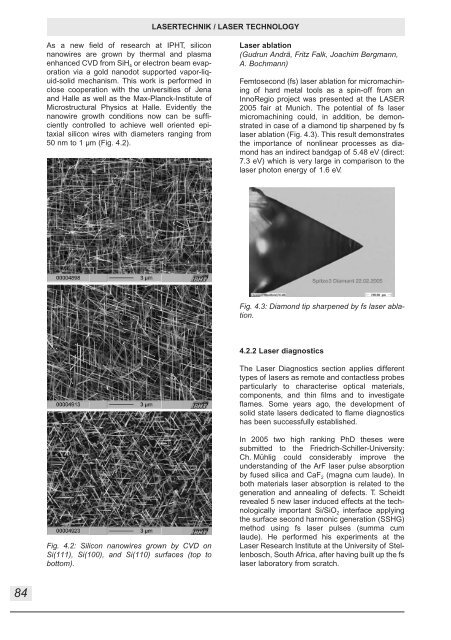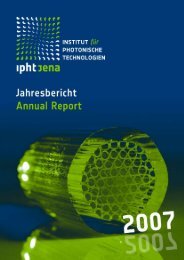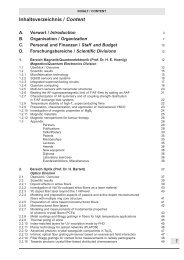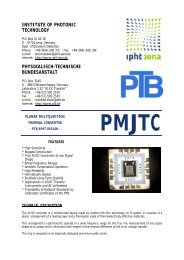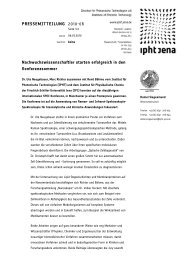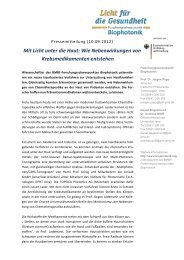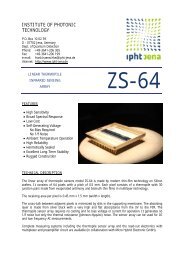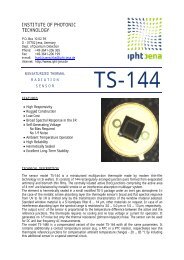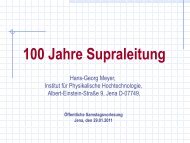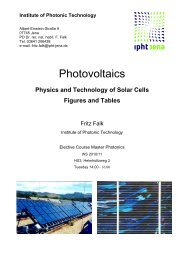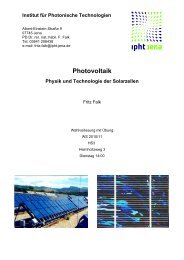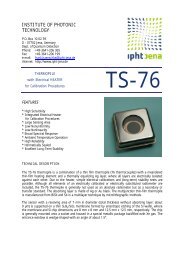Jahresbericht 2005 - IPHT Jena
Jahresbericht 2005 - IPHT Jena
Jahresbericht 2005 - IPHT Jena
You also want an ePaper? Increase the reach of your titles
YUMPU automatically turns print PDFs into web optimized ePapers that Google loves.
84<br />
As a new field of research at <strong>IPHT</strong>, silicon<br />
nanowires are grown by thermal and plasma<br />
enhanced CVD from SiH 4 or electron beam evaporation<br />
via a gold nanodot supported vapor-liquid-solid<br />
mechanism. This work is performed in<br />
close cooperation with the universities of <strong>Jena</strong><br />
and Halle as well as the Max-Planck-Institute of<br />
Microstructural Physics at Halle. Evidently the<br />
nanowire growth conditions now can be sufficiently<br />
controlled to achieve well oriented epitaxial<br />
silicon wires with diameters ranging from<br />
50 nm to 1 µm (Fig. 4.2).<br />
Fig. 4.2: Silicon nanowires grown by CVD on<br />
Si(111), Si(100), and Si(110) surfaces (top to<br />
bottom).<br />
LASERTECHNIK / LASER TECHNOLOGY<br />
Laser ablation<br />
(Gudrun Andrä, Fritz Falk, Joachim Bergmann,<br />
A. Bochmann)<br />
Femtosecond (fs) laser ablation for micromachining<br />
of hard metal tools as a spin-off from an<br />
InnoRegio project was presented at the LASER<br />
<strong>2005</strong> fair at Munich. The potential of fs laser<br />
micromachining could, in addition, be demonstrated<br />
in case of a diamond tip sharpened by fs<br />
laser ablation (Fig. 4.3). This result demonstrates<br />
the importance of nonlinear processes as diamond<br />
has an indirect bandgap of 5.48 eV (direct:<br />
7.3 eV) which is very large in comparison to the<br />
laser photon energy of 1.6 eV.<br />
Fig. 4.3: Diamond tip sharpened by fs laser ablation.<br />
4.2.2 Laser diagnostics<br />
The Laser Diagnostics section applies different<br />
types of lasers as remote and contactless probes<br />
particularly to characterise optical materials,<br />
components, and thin films and to investigate<br />
flames. Some years ago, the development of<br />
solid state lasers dedicated to flame diagnostics<br />
has been successfully established.<br />
In <strong>2005</strong> two high ranking PhD theses were<br />
submitted to the Friedrich-Schiller-University:<br />
Ch. Mühlig could considerably improve the<br />
understanding of the ArF laser pulse absorption<br />
by fused silica and CaF 2 (magna cum laude). In<br />
both materials laser absorption is related to the<br />
generation and annealing of defects. T. Scheidt<br />
revealed 5 new laser induced effects at the technologically<br />
important Si/SiO 2 interface applying<br />
the surface second harmonic generation (SSHG)<br />
method using fs laser pulses (summa cum<br />
laude). He performed his experiments at the<br />
Laser Research Institute at the University of Stellenbosch,<br />
South Africa, after having built up the fs<br />
laser laboratory from scratch.


